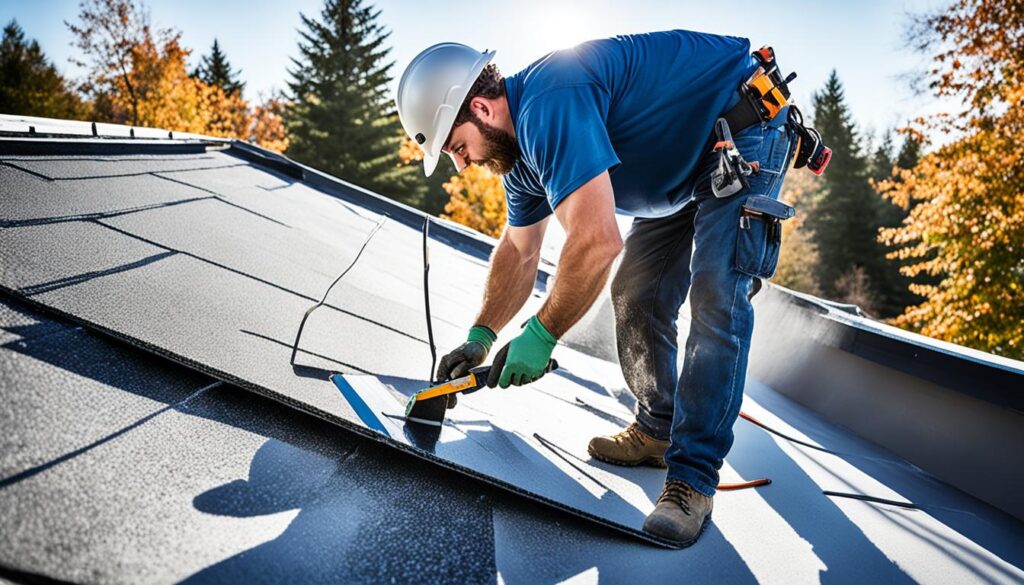
Did you know that 85% of roof leaks happen due to wrong installation or care of materials?1 This shows knowing about roofing tar and cement is very important. They offer different uses and compositions. Knowing which to use helps homeowners and pros do their job right.
Roofing tar is a mix of coal tar, oil, and more. It’s good for fixing leaks on flat roofs.1 Roofing cement is a blend of asphalt, fibers, and mineral spirits. It works as a quick fix for leaks, loose shingles, or small roof problems.1 Both are for fixing roofs, but knowing their different uses is key. This knowledge is vital when dealing with roof leak repair or choosing materials for roofs, especially flats.
Trowel is often used to apply roofing tar. Some types can be applied differently, like paint or caulk.1 Newer tars are safer, without asbestos. They might have solvents, plastics, or mineral fibers to work better.1 Roofing cement is best for quick fixes, not for replacing the whole roof. It’s good for sealing leaks or reattaching shingles for now.1
Knowing how roofing tar and cement differ is vital. It helps homeowners and pros pick the right one. This is needed for using roof sealants, choosing between asphalt and cold process, using flashing adhesives, coating roofs, and various waterproofing products. These are used for roofs with low slopes.
Understanding Roofing Tar
Composition and Origins
Roofing tar is a dark, oily mix. It’s made mainly of coal tar, which is a black or brown leftover from making coal.2 This coal tar gets treated and refined to be safe for roofs. Modern roofing tar doesn’t have asbestos. But it could include things like solvents, plastics, or special minerals to work better.
Types and Applications
Many types of roofing tar are out there. You’ll find them in things like coal tar cement or other spreadable forms.2 Usually, these tars are black, but you can get them in colors like silver or white occasionally.3 Some tars let you paint over them to match your roof’s look. People use roofing tar to seal flat roof leaks.2 There are different ways to put it on, like spreading it or spraying it.
Difference between Roofing Tar and Roofing Cement
Definition of Roofing Cement
Roofing cement is a mix of asphalt, fibers, and mineral spirits. It includes other additives too.1 It’s great for sealing leaks quickly, fixing small roof problems, and reattaching shingles.1 However, it’s only a stopgap measure and not a permanent fix for roofs.1
Differences in Composition and Usage
Roofing tar and cement serve similar purposes but have key differences. Roofing tar is oily and dark. It’s mainly coal tar and petroleum products.1 This makes it perfect for sealing flat roof leaks.1 On the flip side, roofing cement, made of asphalt, fibers, and other stuff, is more versatile. It can seal leaks, fix shingles, and repair roofs.1 Yet, it’s not a long-term fix.1
Rather, roofing cement acts as a temporary solution. It can’t fully replace the need for complete roof replacement.1 Meanwhile, roofing tar provides a lasting solution for flat roof repairs.12

Conclusion
In conclusion, roofing tar and roofing cement serve different purposes in the roofing world. Roofing tar stops leaks on flat roofs4. It’s dark, oily, and made from coal tar and oil. This makes it a good long-term fix for flat roofs.
Roofing cement, on the other hand, acts as a quick fix. It’s a mix of asphalt, fibers, and more. It’s best for sealing leaks, fixing loose shingles, and small roof problems.
It’s important for both homeowners and roofers to know the dissimilarities between these45 materials. This knowledge helps in making smart choices for roof repair and upkeep.
Roofing tar works well on different roof types4, including asphalt, metal, and wood. It can also seal basements, and fix driveway and gutter cracks4. Roofing cement, however, is a quick, not a permanent fix for emergency roof issues. By understanding the unique uses of roofing tar and cement, we can pick the right one. This ensures our roofs stay in good shape for a long time.
Recommended

Meet William Adams, a seasoned roofing expert with over 30 years of hands-on experience in the industry. Having worked tirelessly under the scorching sun and through the fiercest storms, William brings a wealth of knowledge and expertise to the table. Hailing from the heart of the USA, he’s witnessed the evolution of roofing practices firsthand, mastering every aspect along the way. Now retired from the field, William spends his days cherishing time with his loved ones while sharing his invaluable insights through this platform. With William at the helm, you can trust that every tip, advice, and recommendation provided is backed by years of real-world experience and unwavering dedication to quality craftsmanship. Join us as we journey through the world of roofing, guided by the wisdom and passion of a true industry veteran.
